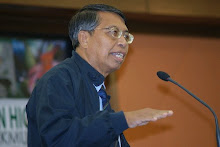1. In late November to early December 2010 over a 100 scientists and their assistants including supporting staffs from Sabah Foundation took part in the Scientific Expedition to Imbak Canyon Conservation Area in Sabah. barely 4 months after the expedition, and especially when many reference collections were yet to be identified and analysed we met again this week to discuss the findings. The seminar was officially opened by ASM Secretary-General Academician Tan Sri Dato Seri Dr. Salleh Mohd. Noor.
2. The geologists led by Prof. Felix Tongkul, Prof. Che Aziz and Sdra Khairul Azlan and soil scientist Dr. Baba Musta made us understand the genesis of the Imbak Canyon. Prior to the expedition we seemed not to know that there was a fault at its southern tip and also a granitic intrusion in between the sandstones and mudstones. The soils are however rich in As and Fe.
3. Dr Mohd Kamil informed us that the river water is of class I but contains a high concentration of Cd. Prof. Abu Hassan and his PhD student Ms Nurita studied the aquatic insects and Dr. A Hamid is still to unzipped the taxonomy of the Gastromyzon fishes.
4. The muscologist Dr. Monica Suleiman believed there were some new records for the Borneon and Sabah bryoflora. She also collected over a hundred specimens of liverworts. Mr. Shim believed there are at least tw new species from the genera Selliguea and Amphineuron (ferns). Mr. John Sugau reported the altitudinal distribution of dipterocarps and Dr. Nazip also mapped the general altitudinal distritribution of non-dipterocarps. There are some possibly new Begonia and orchids. Prof. Laily was disappointed that his lichen collections don't have secondary metabolites. However, all of us observed the beautiful regeneration of seedlings of Dryobalanops lanceolata and other timber species. The largest tree was Shorea johoriensis.
5. There were many reports on fauna. The beetle researchers are still struggling with the identification of the various beetle taxa; Dr. Faszly and his co-workers are also struggling with stick and leaf insects, daddylonglegs, and other invertebrates. Dr. Mahathevi had settled down with her termites; Dr. Norela and her students found both the moth and butterfly fauna not that diverse, while Dr C Y Choong collected a Protosticta sp. which happens to be a new species but awaits description by another specialist in Leiden. The mammalogists thought Imbak Canyon has become a refugia for the small, medium and large mammals as the adjacent areas were somewhat disturbed.
6. Ms. Rashidah M Rehman who successfully climbed Mt. Kuli informed us the Imbak Canyon has some ecotourism potential if packaged scientifically. It has diverse forest landscape, geomorphological landscape, rich flora and fauna including a rich ethno-culture just outside the consevartion area.
7. The social scientists who surveyed the communities of Orang Sungai and Murut took the stage to inform us of the timber-coffins and the rich socio-culture of the various subsects of the Orang Sungai. What intriged me was the fact that some of them decided to prepare their putative coffins when they are still kicking and healthy.
Wednesday, March 16, 2011
Subscribe to:
Posts (Atom)
